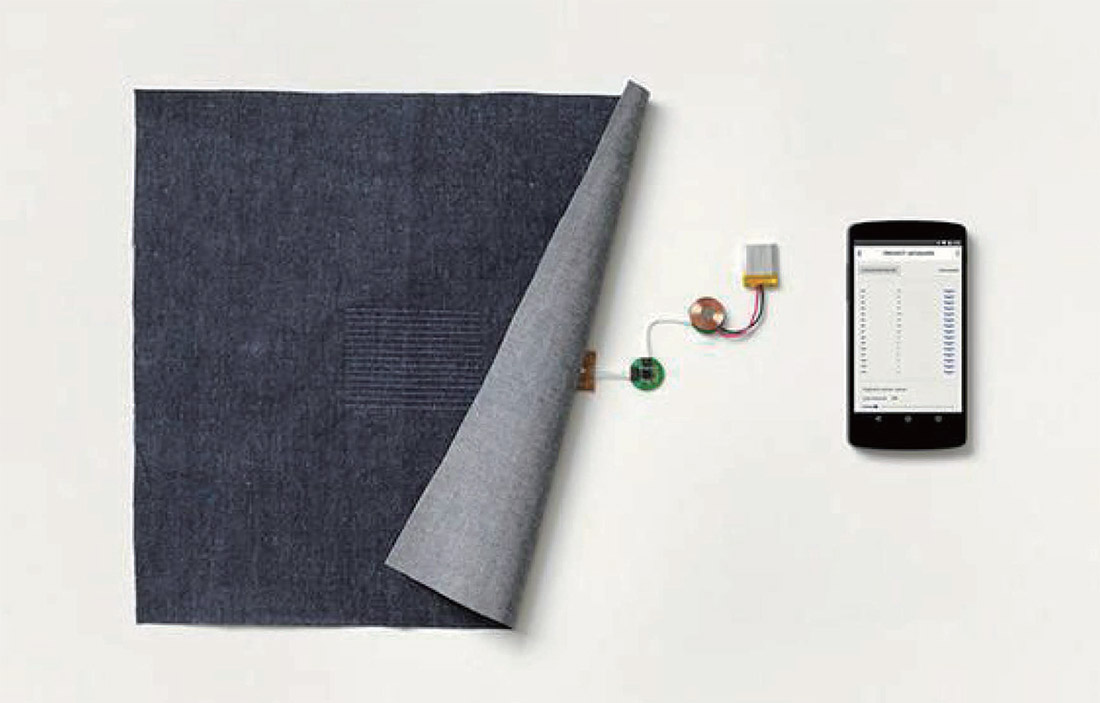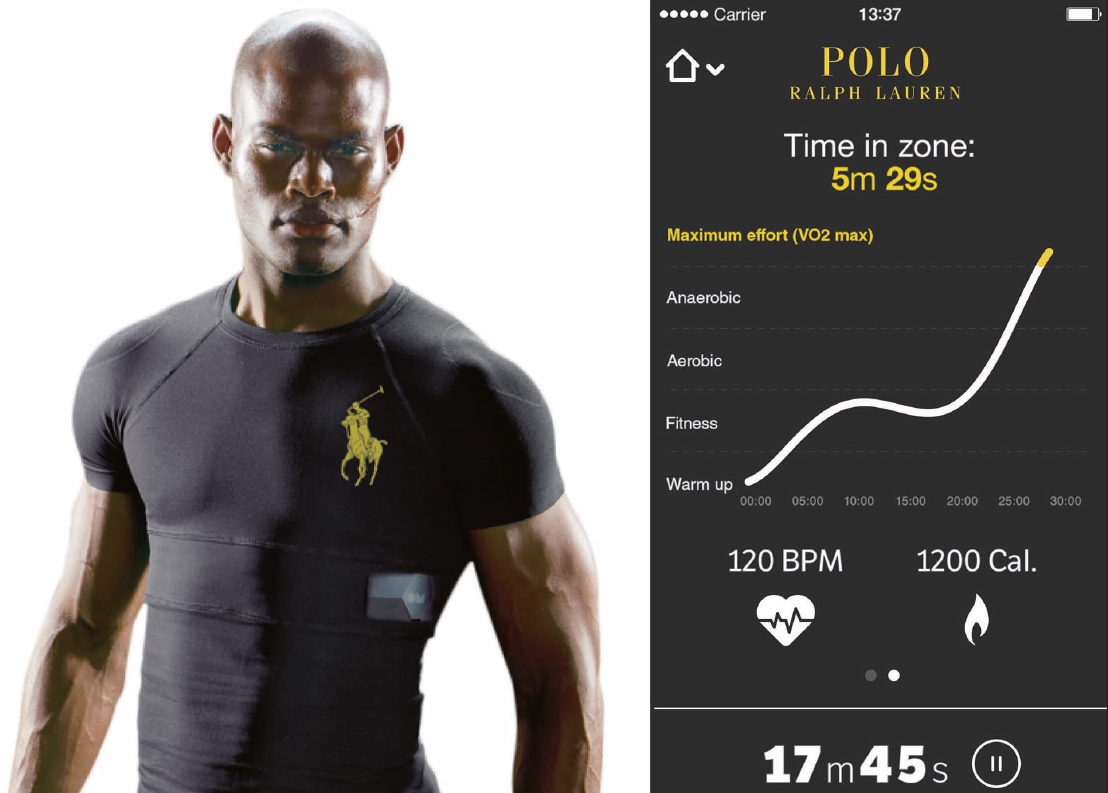- (Free MP3) 배를 두드려 전기 오븐을 켠다

SMART PHONES, SMART WATCHES ... SMART JEANS?
Welcome to the new wave of wearable technology.Smart phones, smart watches ... in the super-speedy cybersphere these are already looking a bit passé. But what about a pair of smart jeans, eh? Not just sartorially smart, but technosmart in its ability to connect with devices around you?
Of all the whizzy projects announced by Google ATAP (the firm’s Advanced Technology and Projects group) at its recent I/O 2015 conference, which ranged from a new modular smartphone to an extra-secure micro-SD card, the one that has really caught the popular imagination is Project Jacquard, which aims to bring connectivity to our clothing.
The weft-and-warp structure of textiles is, oddly, not dissimilar to the structure of electronic “threads” on a touchscreen. Replace some real yarn with conductive threads, the theory goes, and you should end up with cloth that acts as a sensor and can recognize patterns of touch in the way that your mobile or tablet screen does. Then all it needs is a tiny device, no bigger than a button, to pick up these signals and transmit them to your phone, and you’re away.
Ivan Poupyrev, technical program lead at Google ATAP, explains that Project Jacquard is about “making the basic materials of the world around us interactive”.
“We already have clothes,” he adds. “Why do you need a wristband to measure your steps or heartbeat when your shoes or shirt could do it more accurately?”
ATAP projects don’t always work out as planned – Google Glass, for example – but the exciting thing about Jacquard is that it really does seem to have legs. Fashion forecasters certainly think so.
“Yes indeed,” says Sophie-Lucie Dewulf, a senior editor and fashion trend expert at future forecaster WGSN, “projects such as Google Jacquard and E-broidery by Forster Rohner are set for market success.
“Wash-resistant E-fabrics woven or embroidered with conductive yarns are just in the infancy of this technology, yet are starting to reshape the textile industry as designers discover and experiment with the unparalleled added value and potential of sensorial textile technology.”
Conductive yarn isn’t actually such a huge novelty: some shirts are already “connected”. Last year, Ralph Lauren launched a “Polo Tech” shirt, a stretchy, close-fitting “compression shirt” that measures “realtime biometric data” such as your breathing rate and heart rate, and sends the information to the wearer’s iPhone, and rugby players have monitors sewn into their shirts that keep track of their heart rate during games and measure the G-force impact of collisions on the pitch.
What is very new, however, is making conductive cloth on a mass-market scale and in a way that can survive the physical rough-and-tumble of loom weaving, a process that has changed remarkably little in 200 years. (Jacquard itself is a type of fabric with the pattern built into the weave, and it was the invention of the apparatus that allowed this to happen that kicked off the boom in merchanised weaving.)
What is needed to take the concept to the high street is partnership with a large, successful clothing brand, and Google’s first official partner is Levi’s – hence all the talk about smart jeans.
But the great question is, what will smart clothing be able to do? Sophie DeWulf lists pressure measurement (for health), heating (for wellbeing) and illumination (for promotion or safety).
After this point, the mind starts to boggle. Could you turn on the oven by patting your stomach, or turn up the central heating by rubbing both arms vigorously?
And if swiping the connective patch on the sleeve of your jacket will call your loved one or your boss, it’s hard to resist daydreaming of the comic potential should it go wrong. Or if you lend the jacket to someone else. Or if your teenage son programmes the nearest device to yell, “Ow!” every time you sit down.
Levi’s has yet to confirm what products it will actually be making as part of Project Jacquard, though the first should be appearing next year. Until then, we can let our imaginations run riot about the clothes of the future.

배를 두드려 전기 오븐을 켠다
의류에 내장된 센서를 네트워크로 연결하면 착용자의 건강 측정 외에 무한한 가능성 펼쳐져스마트폰, 스마트워치…. 초스피드의 사이버공간에선 약간 한물간 듯이 보인다. 하지만 스마트 진바지라면 어떨까? 스타일 면에서 스마트할 뿐 아니라 주변 기기와 네트워크 구축 기술 면에서도 스마트하다면?
구글 첨단기술·프로젝트(ATAP) 그룹이 최근 열린 개발자 대회 I/O 2015 컨퍼런스에서 각종 최첨단 프로젝트를 발표했다. 새 모듈형 스마트폰부터 보안강화 마이크로-SD 카드까지 다양하다. 그중에서도 정말로 많은 사람의 마음을 사로잡은 신기술은 프로젝트 자카드(Project Jacquard)다. 우리의 옷을 네트워크로 연결하겠다는 구상이다.
직물의 씨실과 날실 구조는 기묘하게도 터치스크린의 전자 ‘스레드(threads, 실행 코드)’ 구조와 크게 다르지 않다. 이론상 일부 진짜 실을 전도성 실로 대체하면 센서 기능을 하는 옷감이 탄생한다. 모바일 기기나 태블릿 스크린처럼 터치 패턴을 인식할 수 있는 옷감이다. 그 다음에는 터치 신호를 포착해 휴대폰으로 전송하는 기능만 갖추면 된다. 단추만한 소형 단말기다. 그게 전부다.
프로젝트 자카드는 “우리 주변 세상의 기본 소재를 쌍방향으로 만든다”는 목표를 지향한다. 구글 ATAP의 기술 프로그램 책임자 이반 푸피레프의 설명이다. “이미 옷은 완성됐다. 신발이나 셔츠로 걸음이나 심박수를 더 정확하게 측정할 수 있게 되면 손목 밴드는 아무 쓸모없다.”
ATAP 프로젝트가 항상 계획대로 풀리지는 않는다(구글 글라스가 대표적이다). 하지만 자카드는 내구성이 있다는 점에서 기대를 모은다. 패션 시장 분석가들은 분명 그렇게 보고 있다.
“실제로 그렇다. 구글 자카드와 스위스 자수업체 포르스터 로너의 E브로이더리(발광 직물) 같은 프로젝트는 시장에서 성공할 확률이 높다.” 미래 예측업체 WGSN의 패션 트렌드 전문가이자 선임 편집자인 소피-루시 드월프의 관측이다. “전도성 실로 짜거나 수놓은 세탁 내성(wash-resistant) E-섬유는 이 기술의 초기 단계에 지나지 않는다. 하지만 벌써 센서 내장 섬유기술의 비할 데 없는 부가가치와 잠재력을 디자이너들이 발견하고 실험하면서 섬유업계의 판도가 재편되기 시작했다.”
전도성 실이 사실상 그렇게 대단한 신기술은 아니다. ‘네트워크로 연결된’ 셔츠도 있다. 지난해 랄프 로렌이 ‘폴로 테크(Polo Tech)’ 셔츠를 선보였다. 신축성 있고 몸에 달라붙는 이 ‘압축 셔츠(compression shirt)’는 호흡수와 심박수 같은 ‘실시간 생체 데이터’를 측정해 그 정보를 착용자의 아이폰으로 전송한다. 럭비선수의 상의에 내장된 모니터는 경기 중 심박수를 모니터하고 충돌의 중력가속도를 측정한다.
진짜 신기술은 따로 있다. 전도성 옷감을 대량생산하면서 직조 과정의 거칠고 험한 과정을 견뎌낼 수 있도록 만드는 기술이다. 직조 과정은 지난 200년 동안 거의 변하지 않았다(자카드는 직조 과정에 패턴이 들어가는 섬유의 일종이다. 이를 가능케 한 장치의 발명으로 직조 제품 붐이 촉발됐다).
이 개념을 대중화하기 위해서는 성공적인 대형 의류 브랜드와 제휴가 필요하다. 구글의 첫 공식 파트너는 리바이스다. 스마트 진 바지가 화제를 모으는 이유다. 그러나 그보다 큰 의문은 스마트 의류가 어떤 기능을 하느냐는 점이다. 소피 드월프 편집자는 압력 측정(건강), 발열(웰빙) 그리고 조명(홍보나 안전)을 꼽는다.
그 다음부터는 기상천외한 아이디어들이 꼬리를 물고 이어진다. 배를 두드려 오븐을 켤 수 있을까, 아니면 양팔을 마구 문질러 중앙난방이 들어오게 할 수 있을까?
겉옷 소매의 네트워크 패치를 긁으면 가족이나 상사와 통화할 수 있다고 하자. 실수로 그랬을 때 일어날 일을 상상만 해도 우스꽝스럽다. 겉옷을 다른 사람에게 빌려줄 경우, 또는 십대 아들 녀석이 가까이 있는 기기를 프로그램해 자리에 앉을 때마다 ‘아야!’하고 비명을 지르게 만들 경우 등등.
프로젝트 자카드의 일환으로 실제 어떤 제품을 만들어낼지 리바이스는 아직 입장을 분명히 밝히지 않았다. 하지만 내년에는 첫 제품이 등장할 듯하다. 그때까지는 미래의 의류에 관해 마음껏 상상의 나래를 펼쳐도 좋을 것이다.
- 번역 차진우
ⓒ이코노미스트(https://economist.co.kr) '내일을 위한 경제뉴스 이코노미스트' 무단 전재 및 재배포 금지










![갓 잡은 갈치를 입속에... 현대판 ‘나는 자연인이다’ 준아 [김지혜의 ★튜브]](https://image.isplus.com/data/isp/image/2025/11/21/isp20251121000010.400.0.jpg)
![딱 1분… 숏폼 드라마계 다크호스 ‘야자캠프’를 아시나요 [김지혜의 ★튜브]](https://image.isplus.com/data/isp/image/2025/11/09/isp20251109000035.400.0.jpg)



당신이 좋아할 만한 기사
브랜드 미디어
브랜드 미디어
“지금 아니면 못사”…퇴직금까지 당겨 쓴 ‘영끌족’ 급증
세상을 올바르게,세상을 따뜻하게일간스포츠
이데일리
일간스포츠
다영, 박재범도 감탄한 바디 여신
대한민국 스포츠·연예의 살아있는 역사 일간스포츠일간스포츠
일간스포츠
일간스포츠
美 테슬라 이어 中 '자율주행 쇼크'…실증 단계 머무른 韓
세상을 올바르게,세상을 따뜻하게이데일리
이데일리
이데일리
홈플러스 회생 D-9…‘유암코·산은·농협’ 삼각 공조 시나리오 부상
성공 투자의 동반자마켓인
마켓인
마켓인
동물의약품 사업에 승부수 던진 유유제약..."美현지화 속도"
바이오 성공 투자, 1%를 위한 길라잡이팜이데일리
팜이데일리
팜이데일리